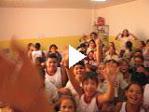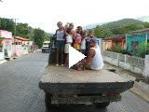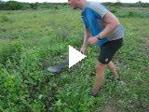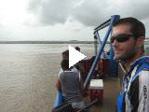Heading south from Puerto Ordaz/Ciudad Guyana (the city seems to have two names), I followed the only road that connects Venezuela and Brazil. Thinly populated, this road follows jungle before climbing into a region known as ‘La Gran Sabana,’ a high grassland with strange flat toped mountains and many rivers and waterfalls. (This is where Angel Falls, the world’s tallest waterfall, is found — it was too far off my route, though). I slowed down through this part, camping on the high mesas and swimming in the many pools, meeting vacationing Venezuelans at the same time.
Entering Brazil, the road descended from the mountains into the Amazon basin, where, after two days of riding, I arrived in the city of Boa Vista. Before entering town, I went swimming with a few teenagers (photo right). I asked the kids if I should worry about piranhas or crocodiles, to which they said ‘don’t worry about it.’
In Brazil, unlike almost every country I have visited, the language is Portuguese instead of Spanish. Fortunately, Spanish and Portuguese are very similar languages, and sometimes I almost understand what people say. Also, some important phrases, such as ‘where is the fire station’ are almost the same in both languages. In Boa Vista, where I stayed for two days, I gave a talk at a middle school. I was able to say a few words in Portuguese, and, whenever what I said was unintelligible, the teacher next to me would repeat what I said in Portuguese (many people here understand Spanish). The bombeiros (firefighters), who I stayed with two nights, also had time to help me congegate verbs, and, when I was interviewed by the local television, I mostly understood the questions and gave responses that might have been understood.
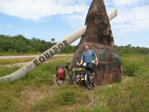
Continuing south, I followed the only major road through this section of the Amazon. While most of this region is pure jungle, and there are very few people and towns, about half the time the roadside is cleared for cattle grazing. The cleared land, however, did make it easier to see the many types of birds (The shot on the right shows me crossing the equator).
Further south, however, a 75 mile stretch of road is indigenous land, reserved for the native peoples, and this is pure jungle. The natives do not like outsiders on their land, and you are only allowed to pass this section during the daytime, and you are not allowed to stop. In talking with people on the road (talking in Portuguese, where we had to say everything a few times), I was amazed at how afraid everyone was of the Indian reservation and the jungle. Most said I would not be able to pass through this section of road. I thought that this was just prejudice against the natives. Before I entered the reserve, one man told me I would be ‘killed and eaten’ by the natives, and then he added something that I didn’t understand and acted out some type of animal with large claws attacking me. I was ready to dismiss what he was saying, but then he said ‘and, this woman had her husband killed and eaten by the natives.’ The woman walked over and confirmed what the man had said. At this point I reconsidered traveling slowly on a bike through the reserve.
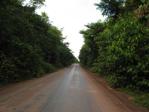
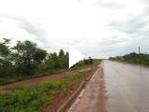
At the reserve´s entrance, though, a police officer changed my mind. He told me that such attacks were far in the past, and that they would never happen along the road in the daytime – the tribes would harm only people who enter their reserve where they are not supposed to. Ok, I thought, and continued to bike the 75 miles, stopping only to pee and get more food out of my pannier (I ate while biking). The jungle here was thick and alive – I saw numerous monkeys (scared a few crossing the road), a small deer like animal, and heard many sounds that I did not hear elsewhere along the road.
On the exit to the reserve, I stopped at a building where some of the indigenous people were selling crarftwork. Both of us speaking Portuguese, which is neither of our first languages, I learned that yes, these people still hunt with bow and arrows and no, they do not drink any coca-cola (they did look very healthy). I asked about bicycles crossing the reserve, and the man said ‘it is allowed, but we do not like it.’
After two more days of travel, mostly through rolling hills, I arrived in the large city of Manaus, which sits where the Rio Negro meets the Amazon River. I will be here for a few days before taking a boat up the Amazon river and into Peru.





